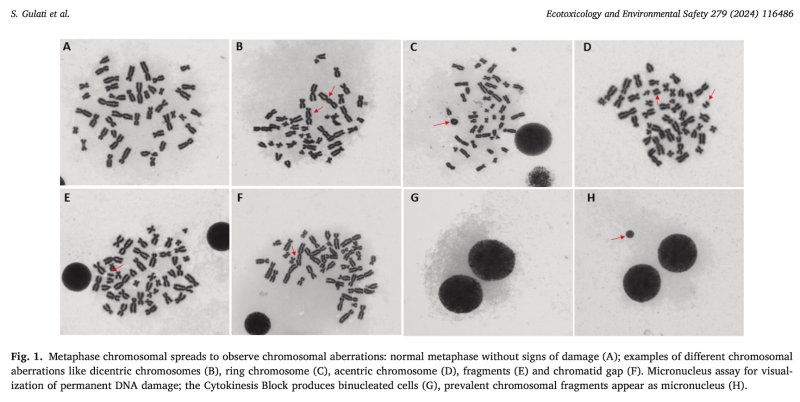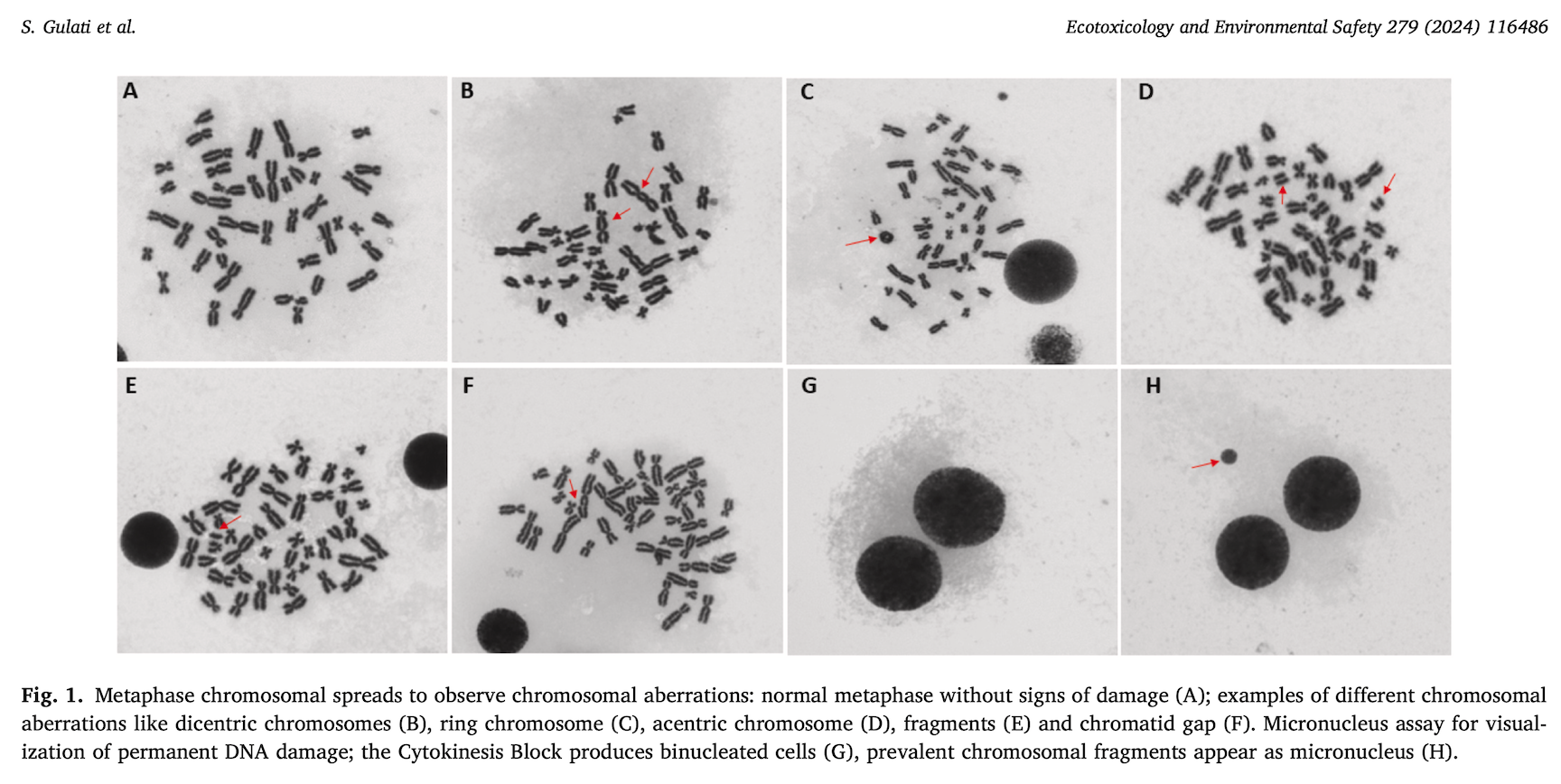Will 5G towers be safer or more dangerous than the longer < 2.5 Ghz waves studied here? Get involved, because the research isn’t even being called for without your demanding it! Your voice matters! Don’t be quiet on this issue!
As Reported by Microwave News, Downplaying RF Causation – When Mosgöller and Belyaev submitted their paper to Ecotoxicology and Environmental Safety, they removed a sentence attributing chromosomal aberrations to RF exposure, citing it as an opinion rather than an observation. This decision facilitated the paper’s immediate acceptance upon resubmission.
Senior European scientists are reporting that people living near cell phone towers show significant changes in their genetic makeup. This is the first time that chronic exposure to cell tower radiation has been linked to unrepairable genetic damage.
A team led by Wilhelm Mosgöller of the Medical University of Vienna and Igor Belyaev of the Slovak Academy of Sciences in Bratislava contends that years of low-dose RF exposure can increase the incidence of various chromosomal aberrations. Such changes could lead to serious health consequences, including cancer and neurological disease.
Assessing Genetic Damage
The research team recruited 24 healthy adults living in rural Germany. Half lived near a mobile phone base station transmitting LTE/GSM signals at frequencies below 2.5 GHz. They were compared to 12 others, similar in most respects except for their proximity to the tower.
Blood samples were taken from the participants and analyzed for oxidative stress, DNA breaks, and chromosomal damage in Belyaev’s lab in Bratislava. A double-blind protocol was followed to guard against potential biases.
The most notable finding is a statistically significant higher incidence of chromosomal aberrations among those living near the tower. DNA breaks and oxidative stress were found to be elevated closer to the towers. Mosgöller maintains that these changes could accumulate over time because natural processes cannot repair broken chromosomes.
Evaluating Oxidative Stress and Genetic Instability Among Residents Near Mobile Phone Base Stations in Germany

The study titled “Evaluation of oxidative stress and genetic instability among residents near” sheds light on this issue, revealing significant findings about the impact of EMFs on human health.
Key Findings of the Study
The study, conducted in Germany, focused on residents living near mobile phone base stations. The researchers aimed to evaluate oxidative stress and genetic instability in these individuals. The key findings include:
- Increased Oxidative Stress: Residents living near mobile phone base stations showed significantly higher levels of oxidative stress markers compared to those living further away. Oxidative stress is known to damage cells and tissues, leading to various health problems.
- Genetic Instability: The study also found increased genetic instability among residents near base stations. This was evidenced by a higher frequency of micronuclei in their blood cells, indicating DNA damage and potential long-term health risks.
- Health Implications: The findings suggest a potential link between chronic exposure to EMFs from mobile phone base stations and increased oxidative stress and genetic damage, which could contribute to the development of various diseases, including cancer.
Background and Context
To provide a comprehensive understanding of the issue, it’s essential to look at the broader context of EMF research. According to a well-done report by Microwave News, concerns about the health effects of EMFs have been ongoing for decades. Various studies have highlighted potential risks, including:
- Cancer Risk: Several studies have suggested a possible association between long-term EMF exposure and an increased risk of cancer, particularly brain tumors.
- Neurological Effects: EMFs have been linked to various neurological issues, including headaches, sleep disturbances, and cognitive impairments.
- Biological Mechanisms: Research indicates that EMFs can cause biological changes at the cellular level, including oxidative stress, DNA damage, and disruption of cellular signaling pathways.
The Study and Its Implications
The tower study, part of the ATHEM-3 project, is the third phase of the longest-running non-governmental research project on RF radiation and health. It was supported by the Kompetenzinitiative, a German non-profit promoting health and environmental protection from wireless technology.
Before investigating chromosomal damage in humans, Mosgöller and his colleagues observed RF-induced DNA breaks in cell cultures. These findings align with previous studies showing RF radiation can lead to DNA breaks by activating biochemical processes that cause oxidative stress and compromised DNA repair.
This new study offers an indication of the possible long-term consequences of DNA breaks observed after short-term exposures. The findings challenge the prevailing dogma that genetic effects are impossible and suggest that even very low ambient levels of RF can be biologically active.
Previous Studies on Chromosomal Aberrations
This study is not the first to link RF radiation to chromosomal aberrations. Notable research from 30 years ago by Vera Garaj-Vrhovac’s team in Croatia and studies at Selcuk University in Turkey also found higher values of chromosomal aberrations among individuals living near mobile phone towers, although statistical significance was not always achieved.
The Alarming Regulatory Landscape
The study’s findings are particularly concerning in light of recent developments in regulatory oversight. The U.S. National Toxicology Program (NTP) had previously identified clear evidence of cancer related to cell phone radiation. However, despite these alarming results, the NTP has halted further research on the biological and environmental impacts of cell phone radiofrequency radiation, citing resource constraints and technical challenges. This decision represents a significant abdication of responsibility, leaving the public vulnerable to potential health risks from long-term, non-thermal exposure levels that current guidelines do not adequately address.
FCC’s Outdated Guidelines and Legal Challenges
The Federal Communications Commission (FCC) has also come under fire for its failure to update safety guidelines established over two decades ago. These guidelines, which only consider thermal risks, are woefully inadequate in addressing the broader spectrum of health risks posed by prolonged exposure to non-ionizing radiation from modern wireless devices. In a historic ruling, the United States Court of Appeals for the District of Columbia Circuit found that the FCC’s decision to retain its outdated safety limits was “arbitrary and capricious,” and ordered the commission to explain why it ignored scientific evidence showing harm from wireless radiation.
Comprehensive Research Evidence: A Call for Caution
The cell tower radiation study adds to a growing body of research indicating potential health risks associated with electromagnetic radiation from wireless devices. Major studies such as the Interphone study, Hardell group studies, CERENAT study, U.S. National Toxicology Program (NTP), Ramazzini Institute Study, REFLEX Project, BioInitiative Report, and the work of researchers like Dr. Henry Lai collectively point towards increased health risks. These findings highlight the urgent need for updated safety guidelines and continued research to protect public health.
Biological Interactions Beyond Thermal Effects
Further complicating the regulatory landscape is the emerging evidence of biological interactions with electromagnetic radiation beyond thermal effects. For example, the FDA-approved TheraBionic treatment, which uses RF radiation at power levels significantly lower than those emitted by cell phones, effectively treats inoperable liver cancer through non-thermal interactions. This underscores the potential for non-thermal effects of RF radiation to influence biological systems, challenging the traditional view that non-ionizing radiation is biologically inert.
The Urgent Need for Updated Guidelines and Continued Research
The new study on cell tower radiation and genetic changes exemplifies the critical need for updated safety guidelines and continued research into the health impacts of wireless radiation. The cessation of NTP research and the FCC’s failure to update its guidelines represent significant regulatory failures that leave the public at risk. As the use of wireless technology continues to grow, it is imperative that regulatory bodies prioritize public health by addressing the full spectrum of potential risks associated with long-term exposure to non-ionizing radiation.








